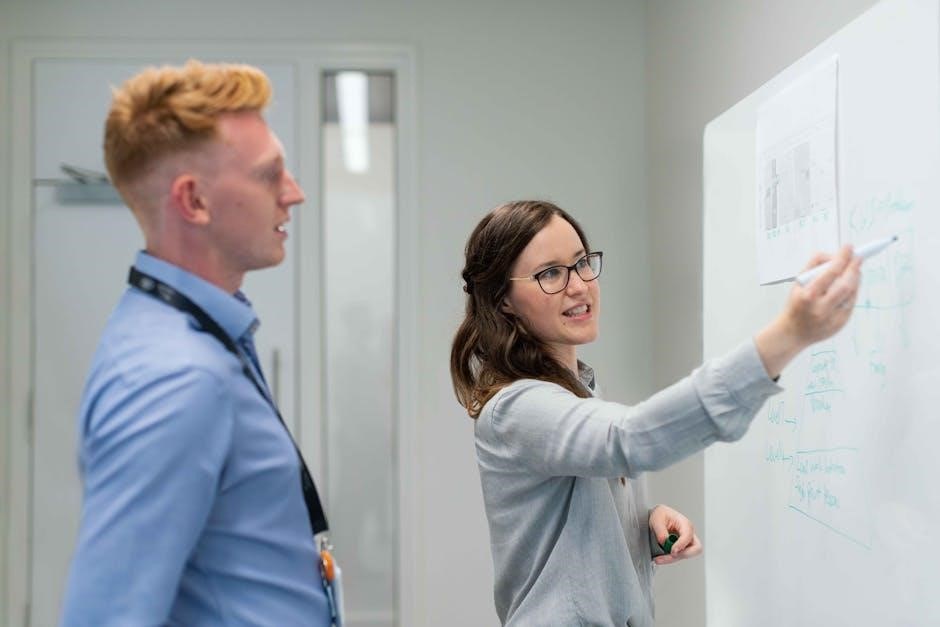
mastering guide
Mastering is the final step in music production, enhancing a mix to sound professional. It balances elements and prepares the track for distribution. A good master ensures clarity, consistency, and impact across all playback systems, making it essential for delivering high-quality audio to listeners.

What is Mastering and Why is it Important?
Mastering is the final step in music production, where a mixed audio track is enhanced to achieve optimal sound quality. It ensures the track is balanced, with proper loudness and clarity, making it suitable for distribution across various platforms. Mastering corrects mix issues, enhances dynamics, and ensures consistency in playback across different devices. A well-mastered track stands out professionally, delivering the intended emotional impact to listeners. Without mastering, music may lack polish and fail to compete with industry standards. It’s a critical process that bridges the creative mix and the final product, ensuring the artist’s vision is realized in the best possible way.
The Role of a Mastering Engineer
A mastering engineer is a skilled professional responsible for enhancing and finalizing mixed audio tracks. Their expertise ensures the music sounds optimal across all playback systems. Using tools like DAWs, plugins, and hardware, they adjust EQ, compression, and stereo imaging to achieve clarity and balance. The engineer also ensures proper loudness and headroom, preparing the track for distribution. Beyond technical skills, they bring a fresh perspective to the music, often identifying and correcting mix issues. A good mastering engineer understands the artist’s vision and enhances the emotional impact of the track. Their work is crucial for delivering a polished, professional product that meets industry standards and resonates with listeners.

Preparing Your Mix for Mastering
Ensure your mix has proper headroom, balanced levels, and clear frequencies. Export in high quality, check for noise, and avoid over-compression to allow mastering engineers flexibility.
Key Elements to Check Before Mastering
Before mastering, ensure your mix is well-balanced and polished. Check headroom to avoid clipping, ensuring peaks are below -6dB. Verify loudness levels are appropriate for your genre. Balance frequencies to ensure clarity across bass, midrange, and treble. Stereo imaging should be accurate, with elements properly placed. Reduce noise and hum where necessary. Ensure sample rate and bit depth match your mastering goals. Export in high-quality formats like WAV. Avoid over-compression and excessive EQ. Listen on different speakers to identify issues. Make sure the mix translates well across various playback systems. Proper preparation ensures mastering engineers can enhance your track effectively, achieving professional results.
Headroom and Loudness: Best Practices
Headroom is crucial for mastering, providing space for dynamic processing. Maintain at least -6dB of headroom on your mix to prevent distortion. Loudness should be balanced, avoiding excessive levels that squash the audio. Aim for an integrated loudness of -14 to -12 LUFS for most genres. Use metering tools to monitor RMS and peak levels. Avoid over-limiting, as it can cause artifacts and loss of detail; Ensure your master isn’t overly compressed, preserving natural dynamics. Reference tracks can help match loudness and tone. Leave headroom for the mastering engineer to work effectively. Proper balance ensures your music sounds great on all platforms and systems, maintaining clarity and impact.

Choosing the Right Tools for Mastering
For mastering, use a professional DAW like Ableton, Logic, or Pro Tools. Essential plugins include EQ, compression, and limiters. Hardware options like outboard gear can enhance sound quality. Invest in accurate monitoring speakers and reference tracks for consistent results. Utilize metering tools to ensure proper loudness and headroom. A combination of high-quality software and hardware ensures professional-sounding masters tailored to your music’s needs.

Digital Audio Workstations (DAWs) for Mastering
Popular DAWs for mastering include Ableton Live, Logic Pro, and Pro Tools. These platforms offer advanced tools for precise audio manipulation. Ableton excels in creative workflows, while Logic Pro provides robust metering and EQ options. Pro Tools is industry-standard, known for its reliability and professional features. Each DAW includes essential plugins like compressors, limiters, and stereo imagers. Additionally, metering tools help maintain optimal loudness and headroom. When choosing a DAW, consider its compatibility with your system and the specific needs of your project. Many mastering engineers also use DAWs alongside external hardware for enhanced sound quality. With the right DAW, achieving professional results is accessible even in a home studio setting.
Hardware and Software Plugins for Mastering

Mastering relies on a combination of hardware and software tools to achieve professional results. Software plugins like iZotope Ozone, FabFilter Pro-Q, and Waves C4 are essential for tasks like EQ, compression, and stereo imaging. Hardware units, such as Pultec equalizers or LA-2A compressors, are often used for their unique sonic characteristics. Metering tools like MeterPlugs or Tonal Balance Control help ensure balanced frequency response. Reference tracks are also crucial for comparison. While software offers versatility, hardware provides warmth and depth. The right combination of tools enables mastering engineers to enhance clarity, dynamics, and loudness, ensuring the final product sounds polished and competitive across all playback systems.

The Mastering Process: Step-by-Step Guide
The mastering process involves importing the mix, adjusting EQ, compression, and stereo imaging, metering levels, and exporting the final file. Reference tracks help achieve desired sound and consistency across systems.
How to Master a Song at Home
Mastering a song at home is achievable with the right tools and knowledge. Start by setting up a Digital Audio Workstation (DAW) like Ableton or Logic Pro. Use plugins such as EQ, compression, and limiters to enhance your mix. Ensure proper headroom by leaving space between the loudest peaks and 0 dBFS. Reference tracks can guide your adjustments. Export in high-quality formats like WAV for distribution. Practice is key to refining your skills and achieving professional-sounding results without expensive studio equipment.
Using Reference Tracks for Better Results
Reference tracks are crucial for achieving professional-sounding masters. Choose songs similar to your genre and style to guide your adjustments. Compare your mix to these tracks, focusing on elements like balance, clarity, and loudness. Use them to ensure your master translates well across different playback systems. By matching the tone and dynamics of professional recordings, you can enhance your track’s quality and consistency. Regularly A/B compare your mix with references to maintain objectivity. This practice helps identify areas for improvement and ensures your final master meets industry standards for clarity and impact.

Best Practices for Achieving Professional Results
Mastering requires precision and attention to detail. Use reference tracks, maintain headroom, and ensure consistency across playback systems. Collaborate with professionals and avoid over-processing to preserve the mix’s integrity.
Tips for Collaborating with a Mastering Engineer
Effective collaboration with a mastering engineer ensures your vision is realized. Provide clear feedback and reference tracks to guide their work. Share your goals, such as desired loudness or tone. Ensure your mix is well-prepared, with proper headroom and no over-processing. Communicate openly about specific issues or areas needing attention. Trust their expertise but remain involved to ensure alignment with your artistic intent. Ask questions to understand their process and decisions. Regularly review and approve iterations to achieve the best possible outcome. A good engineer will enhance your mix while preserving its integrity, so maintain open dialogue throughout the process.
Common Mistakes to Avoid in Mastering
One common mistake in mastering is over-compression, which can make a track sound lifeless. Avoid excessive limiting to maintain dynamic range. Ensure proper headroom in your mix to prevent distortion during mastering. Overusing EQ can lead to imbalances, so make subtle adjustments. Additionally, not referencing your track on multiple playback systems can result in inconsistent sound. Rushing the mastering process is another pitfall; allow time for revisions. Lastly, don’t master in a fatigued state—take breaks to ensure clarity. By avoiding these errors, you can achieve a polished, professional master that translates well across all listening environments.

Learning and Growth in Mastering
Mastering requires continuous learning and practice. Stay updated with industry trends in 2025, explore online resources, and refine your skills through hands-on experience and workshops.
How to Learn Mastering: Resources and Techniques
Learning mastering involves practice, patience, and the right resources. Start with free online mastering chains and tutorials on platforms like YouTube. Use tools like iZotope Ozone and Tonal Balance Control to refine your skills. Experiment with reference tracks from your genre to understand professional sound. Join forums like Reddit’s professional audio community for feedback and insights. Enroll in workshops or online courses to deepen your knowledge. Collaborate with mastering engineers for hands-on experience and guidance. Regularly update your techniques to align with industry trends in 2025. Consistent practice and staying curious are key to mastering audio effectively.

Staying Updated with Industry Trends in 2025
In 2025, the mastering industry continues to evolve with advancements in technology and changing listener preferences. Staying updated requires embracing AI-powered mastering tools, which are increasingly popular for their efficiency and precision. Reference tracks remain crucial for ensuring your work aligns with contemporary standards. Additionally, immersive audio formats are gaining traction, offering new dimensions for mastering engineers to explore. Engaging with professional communities and attending workshops can provide insights into the latest techniques. Subscribing to industry blogs and following expert mastering engineers on social media keeps you informed about emerging trends. Continuous learning and adaptability are essential to remain relevant in this dynamic field.